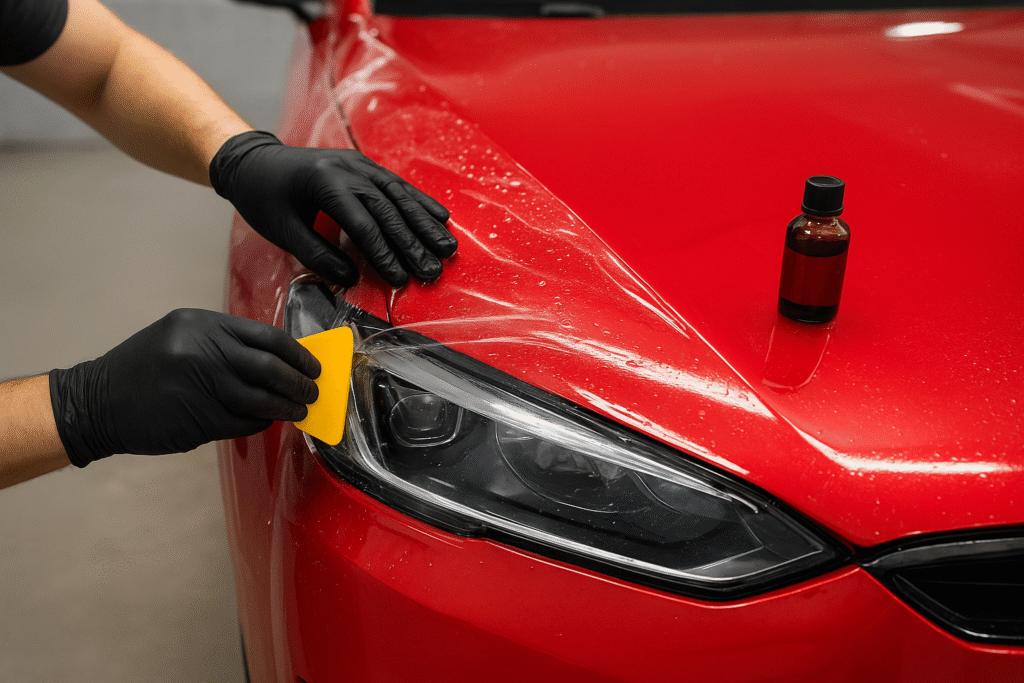Paint protection film (PPF) is a transparent, durable urethane layer applied to a car’s exterior to guard against scratches, chips, stains, and weather damage. It serves as a nearly invisible shield that helps maintain a vehicle’s paint condition, preserving its appearance over time. This film is especially useful for drivers looking to protect their investment from daily wear and tear caused by road debris and environmental factors.
Modern PPF differs from older clear bras by offering stronger impact resistance and improved longevity. It is available in pre-cut kits tailored to specific vehicle panels, making installation easier for professionals and DIY enthusiasts alike. The growing availability of high-quality films means car owners can choose effective protection solutions without excessive costs.
Understanding how paint protection film works and its benefits can help car owners decide if it fits their needs. This knowledge guides them in selecting the right product and installation method to keep their vehicle looking newer, longer.
Understanding Paint Protection Film for Cars
Paint protection film for cars are specialized material designed to shield a car’s surfaces from damage while maintaining its appearance. Its composition, types, and functional mechanisms determine how well it preserves vehicle paint over time.
What Is Paint Protection Film?
Paint protection film is a transparent, flexible layer made mostly from thermoplastic polyurethane. It is applied directly to exterior parts of a vehicle, such as the hood, fenders, and bumpers. The film acts as a barrier against physical damage like scratches, rock chips, and minor abrasions.
Unlike traditional clear bras, modern PPF is thinner, more durable, and often features self-healing properties. This means minor scratches can disappear over time with heat or sunlight exposure. PPF also protects against UV rays, preventing paint fading and discoloration. Its invisible nature allows the vehicle’s original paint and finish to remain visible.
Types of Paint Protection Film
PPF comes in several varieties, each with features tailored to different needs:
- Glossy Film: Enhances and maintains a shiny, polished look.
- Matte or Satin Film: Preserves matte finishes without altering the car’s original appearance.
- Self-Healing Film: Contains special polymers that repair small scratches automatically.
- Hydrophobic Film: Repels water and dirt, making cleaning easier.
Choosing the right type depends on the vehicle’s finish and the owner’s priorities related to appearance and protection. Professionals often recommend self-healing films for high-impact areas and hydrophobic coatings for ease of maintenance.
How Paint Protection Film Works
Paint protection film functions as a physical shield between the external environment and the car’s paint. It absorbs and disperses impacts from debris like stones or bugs, which otherwise would chip or scratch the surface.
The material’s elasticity allows it to stretch and conform to complex curves, ensuring complete coverage. Modern PPF often includes self-healing technology, where microcapsules within the film enable surface scratches to vanish when exposed to heat. Additionally, by blocking UV radiation, the film prevents sun damage, preserving the paint’s original hue.
Regular cleaning and proper maintenance help maintain PPF’s effectiveness and appearance over time, extending the life of both the film and the vehicle’s paint.
Benefits and Application of Paint Protection Film
Paint protection film offers durable defense against common paint damage while requiring specific care and installation methods. Its advantages include impact resistance and UV protection, but proper application and maintenance are essential to maximize its lifespan.
Advantages of Paint Protection Film
Paint protection film (PPF) is a transparent polyurethane layer that shields a vehicle’s paint from rock chips, scratches, and environmental contaminants. It resists damage from road debris, insect acids, bird droppings, and UV rays, preventing fading and surface deterioration.
PPF also often features self-healing properties that allow minor scratches to disappear with heat exposure. This ability reduces the need for frequent touch-ups. Additionally, PPF helps retain a vehicle’s resale value by preserving the factory paint finish, which can be costly to repair or replace.
Professional vs. DIY Installation
Professional installation of PPF ensures precise fitting, bubble-free application, and adherence to complex curves. Experts use specialized tools and heat guns to stretch and bond the film securely. They also provide warranties on labor and materials, adding peace of mind.
DIY installation kits are available and cheaper, but require skill, patience, and a controlled environment to avoid imperfections like wrinkles and dust inclusion. Improper installation can lead to premature peeling, reduced protection, and a less aesthetic finish. For most vehicle owners, professional installation is the recommended option due to its reliability and quality.
Maintaining Paint Protection Film
Maintaining PPF involves gentle cleaning and avoidance of harsh chemicals. Use pH-neutral car wash soap and soft microfiber cloths to clean the surface without scratching. Avoid automatic car washes with abrasive brushes that can damage the film.
Regularly inspecting the film for edges lifting or debris buildup helps prevent long-term issues. Some PPFs require occasional reapplication of compatible sealants or protective coatings to maintain hydrophobic properties and enhance durability. Proper maintenance can extend the functional life of PPF to several years.
